EV Main Insight Module in Weekly Energy Update Emails
The EV Main Insight in Weekly Energy Update (WEU) module can be included in the WEU Post Bill Report emails. The module is designed to give customers that charge electric vehicles (EVs) at their homes an overview of their monthly charging habits and encourage them to shift their charging to times the utility prefers, such as when there is low demand on the grid or when there is high availability of renewable energy.
The module includes several sections, and can vary depending on how much the customer is charging their vehicle during high-demand times. The module includes:
- Graphical information about when the EV is charging
- Insights about the best times to charge an EV
- Motivational information related to the benefits of shifting charging to low-demand times
- Marketing content (optional)
Requirements
This module is currently available only for homes with L2 chargers, and requires that the utility has hourly disaggregation enabled.
For all other requirements, see:
Design
This image shows an example of the EV Main Insight in Weekly Energy Update Emails module:
Figure 6-3 EV Main Insight in Weekly Energy Update Module
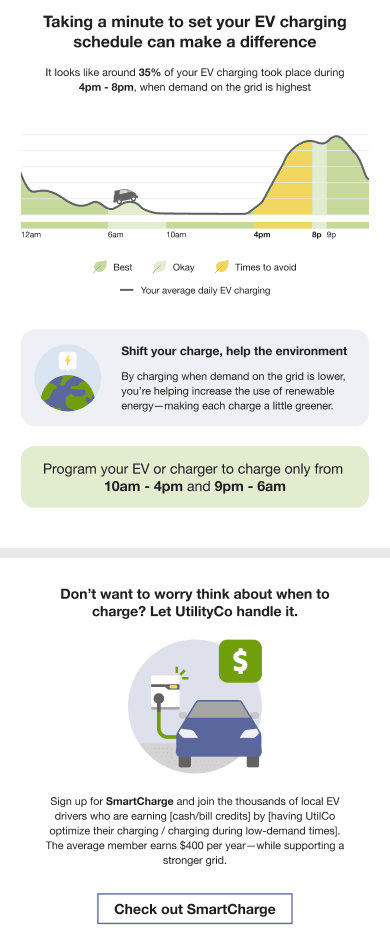
User Experience Variations
This section describes how the module can vary.
Success State
A success state occurs when the user charges their EV during the hours that the utility has specified as "times to avoid" less than the threshold that is set by the utility. By default, the threshold is set to 10%. Therefore, if the user charged their EV 8% of the time during the times to avoid, they would fall into the Success state.
In this state, the email varies as follows:
- Header Statement: The header statement reads, "Thank you! Your EV charging schedule is making a difference."
- Charging Time Statement: The statement reads, "Less than 10% of your EV charging took place during <hours> when demand on the grid is highest".
- Motivation Statements: The motivation statement is removed from the module.
- Promotion: If a promotion is included in the module, it is displayed in a similar format to the motivation statements in other states.
- Time to Charge Statement: This statement is removed from the module.
Figure 6-4 Success State Variation
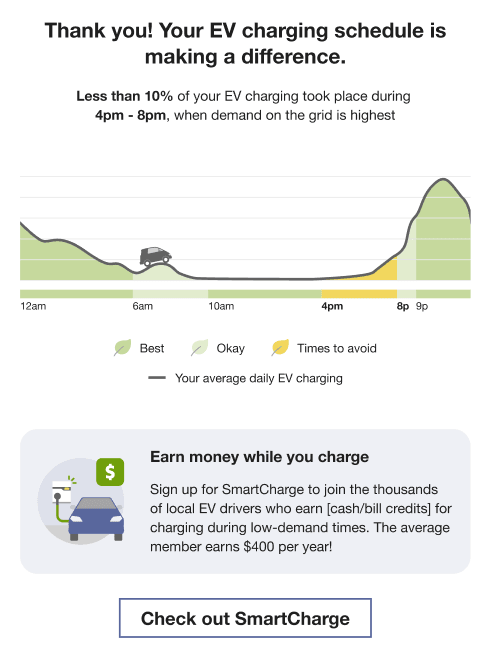
Needs Improvement State
This state occurs when the user charges their EV during high-demand times more than the threshold that is set by the utility, and they were not previously in the Success state. By default, the threshold is set to 10%. For example, if the user did 20% of their EV charging during high-demand periods this bill period, and they were not in a Success state last bill period, they would fall into this state.
In this state, the email varies as follows:
- Header Statement: The header statement reads, "Taking a minute to set your EV charging schedule can make a difference".
- Charging Time Statement: The statement reads, "It looks like around X% of your EV charging took place during <hours>, when demand on the grid is highest". The percentage is rounded to the nearest 5%.
- Time to Charge Statement: The statements in this section begin with one of the following:
- "Best times to charge are from" and the statement is followed by the time blocks the utility has identified as the best charging periods.
- "Better times to charge are from" and the statement is followed by the time blocks the utility has identified as the best and okay charging periods.
Transition State
This state occurs when the user charges their EV during high-demand times more than the threshold that is set by the utility during this bill period, but they were in a Success state during the previous bill period. For example, if they did 5% of their charging during high-demand times last bill period, but did 20% of their charging this period during high-demand times, they fall into the Transition state.
In this state, the email varies as follows:
- Header Statement: The header statement reads, "Your EV charging patterns may have changed".
- Charging Time Statement: The statement reads, "It looks like around X% of your EV charging took place during <hours>, when demand on the grid is highest". The percentage is rounded to the nearest 5%.
- Time to Charge Statement: The statements in this section begin with one of the following:
- "Best times to charge are from" and the statement is followed by the time blocks the utility has identified as the best charging periods.
- "Better times to charge are from" and the statement is followed by the time blocks the utility has identified as the best and okay charging periods.
Charging Graph Variations
The charging graph can vary depending on whether utilities that have specified two or three time blocks in their schedule. Utilities with two time blocks will show Best and Times to Avoid in the chart, while utilities with three time blocks will show Best, Okay, and Times to Avoid in the chart.
Utility specifies two time blocks:
Figure 6-5 Two Time Blocks
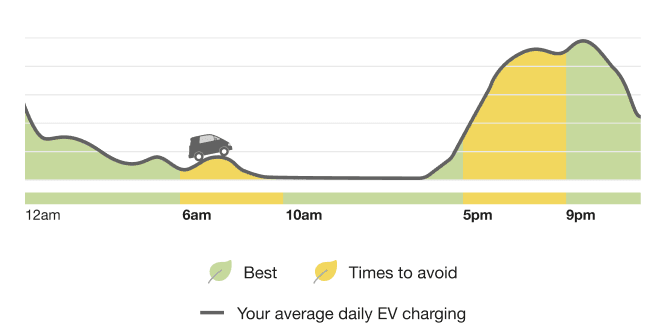
Utility specifies three time blocks:
Figure 6-6 Three Time Blocks
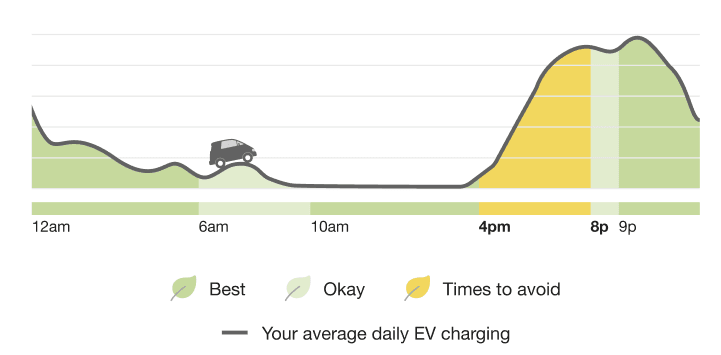
Motivation Statements
Utilities can choose from six motivation statements that can be included in the email on a rotating basis. The following images show the available motivation statements. Note that in mobile formats, the images appear above the statements rather than beside the statements.
Figure 6-7 Motivation Statements

Promotions
Utilities can choose to include one of three promotions in the module:
- Smart Charger promotion (shown below)
- TOU Rate Plan promotion (shown below)
- Custom promotion
When included in a Success state email, promotions are displayed using a similar format to the motivation statements, as shown here:
Figure 6-8 Success State Promotion
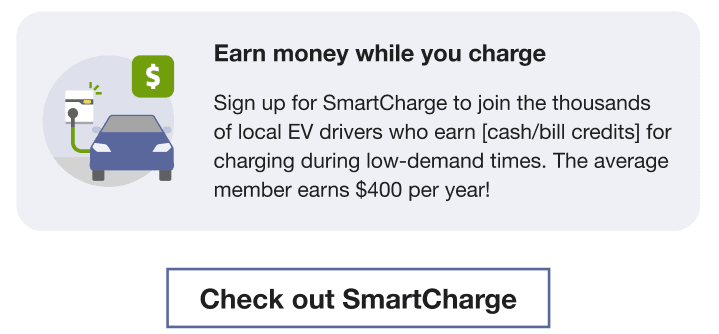
When included in the Needs Improvement or Transition states, the promotion is displayed at the bottom of the module, and is separated by a bar, as shown here:
Figure 6-9 Promotion in Other States
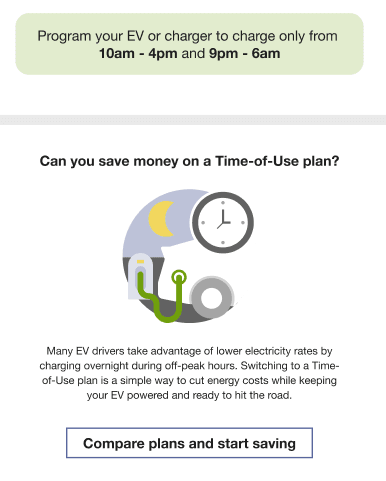
Configuration Options
For each element listed in the table, indicate the desired configuration in the Input Value column. If you do not provide an input for optional configurations, the default will be used.
Table 6-7 Configuration Options
| Configuration Option | Input Value |
|---|---|
|
Images The images can be configured to use client-specific colors. Other than that, the image can not be changed. |
Optional Specify client branding colors. |
|
Icons in the Chart Legend Utilities can specify whether they want to use leaves in the chart legend or rounded boxes. |
Required Specify one of these options:
|
|
Threshold Percentage Utilities can specify the percentage of EV charging that is used to determine whether customers are in a success state. The default threshold his 10%. Using this threshold, customers who do less than 10% of their EV charging during high-demand periods will be in the success state. Customers who are over 10% will be in the Needs Improvement or Transition state. Oracle recommends not using a value over 15%, and all values must be a multiple of 5. Default: 10% |
Optional Specify one of these options:
|
|
Time Blocks Utilities can define whether they have 2 or 3 time blocks. These blocks are typically similar to the different peak periods for customers on Time-of-Use rates. For utilities with 2 time blocks, you must define which block is the "Times to Avoid" block, and all remaining hours are classified as “Best”. For utilities with 3 time blocks, specify both the "Times to Avoid" and the "Okay" times. All other hours are classified as "Best". This option is used to determine how the chart renders. Utilities with 3 time blocks should also review the Time Focus configuration option to determine how their Times to Charge statements are displayed. |
Required Specify one of these options:
|
|
Time Focus Utilities that have 3 time blocks can define the focus of the Time to Charge statement in the module, as follows:
This option is not used for utilities with only 2 time blocks. |
Required if Using 3 Blocks Specify one of these options:
|
|
Motivations The text and images included in the motivations can be customized to meet the needs of the utility. |
Optional Specify one of these options:
|
|
Missing Disaggregation Days Allowed Specify the number of days that disaggregation data can be missing before the module fails. For example, if you set this option to 2, the module will fail if there are 3 days of disaggregation data missing for the bill period. Note that the email is sent without this module if it fails. Default: 2 days |
Optional Specify one of these options:
|
|
Total EV Charging Threshold Specify the required amount of EV charging that must be detected for the module to be included. For example, if you set this option to 5 kWh, the module will fail if the customer's EV charging totals 4kWh. Note that the email is sent without this module if it fails. Default: 5 kWh |
Optional Specify one of these options:
|
To see how this module fits into the overall user experience, see Design and Configuration.